From the Resene paint and decorating problem solver
On a roll... measuring, cutting and hanging wallpaper
Wallpapering is a popular way of achieving different textural and patterned effects to add character to rooms. The ever-increasing variety of wallpaper textures, patterns and colourways makes it easy to add a new element into your home. As with most projects, it pays to know what you’re doing before you start. A quick guide for wallpapering follows – check with Resene ColorShop staff if you need any more information before you start the work.
You will need: bucket, ladder, layout brush, paper smoother, pater tiger stripper, paste brush, plumb bob, scissors, size, snap knife, sponge, stripping knife, sugar soap, trim guide, wallpaper paste, wallpaper trough.
As with painting, it is important to get the surface preparation right to ensure your finished handiwork looks its best for as long as possible. If you are planning to paint areas such as ceiling, joinery and trim, do this work first to avoid damaging any new wallpaper. Paint the highest areas first, such as the ceiling, then work your way down to windows, doors and then finish with the floor and skirting boards.
If the walls are already wallpapered, all existing wallpaper must be removed. Wet the walls with Metylan Wallpaper Remover to soften the wallpaper. Start wetting from the bottom and work up. Let the water soak into the paper and do the work. Don’t rush.
When all the wallpaper has been removed allow the wall surface to dry completely, then sand with 100 grit aloe sandpaper to remove all nibs etc. and dust the walls. Fill all imperfections with a sandable filler, sand smooth and dust the entire surface then size before hanging your new wallpaper.
If your walls have been painted with an enamel (high gloss) paint such as in kitchens, bathrooms and so on, wash the entire surface with sugar soap then rinse with clean water. When dry sand the entire surface with 80 grit aloe sandpaper to give a good grip or key for your size and paste to adhere to. Dust the entire surface to remove all dust particles, size the walls, then hang your wallpaper.
Treat all areas of mould with Resene Moss & Mould Killer. Identify the source of the dampness and fix to prevent any reoccurrence.
Sand new paperfaced plasterboard with 100 grit sandpaper to remove any nibs and so on, dust completely and apply two coats of size to allow for better slip and slide when hanging your wallpaper.
Sand yellowed or water soluble stained paperfaced plasterboard with 100 grit sandpaper, dust the entire surface and apply a coat of Resene Sureseal pigmented sealer. Leave as long as possible for the sealer to cure, then sand the entire surface with 80 grit sandpaper to give a good key for your size and paste to adhere to. Dust the entire surface to remove all dust particles and size the full wall area before hanging your wallpaper.
Latex size may only be used under paper backed products.
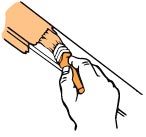
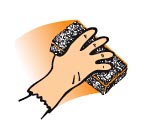
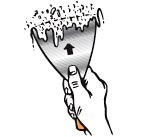

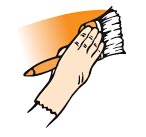
Measure the height of the walls to be prepared and the total length around the room (including doors and windows) and refer to this chart for the number of rolls.
| Wall height | Distance around room (doors and windows included) | |||||||||||||||||
|---|---|---|---|---|---|---|---|---|---|---|---|---|---|---|---|---|---|---|
| Metres | 9.75 | 10.97 | 12.79 | 13.41 | 14.63 | 15.85 | 17.07 | 18.29 | 19.51 | 20.73 | 21.95 | 23.16 | 24.38 | 25.60 | 26.82 | 28.04 | ||
| 2.13 to 2.29 | 4 | 5 | 5 | 6 | 6 | 7 | 7 | 8 | 8 | 9 | 9 | 9 | 10 | 10 | 11 | 11 | ||
| 2.30 to 2.44 | 4 | 5 | 5 | 6 | 6 | 7 | 8 | 8 | 9 | 9 | 10 | 10 | 11 | 11 | 12 | 12 | ||
| 2.45 to 2.59 | 5 | 5 | 6 | 6 | 7 | 7 | 8 | 8 | 9 | 9 | 10 | 10 | 11 | 12 | 13 | 13 | ||
| 2.60 to 2.74 | 5 | 5 | 6 | 6 | 7 | 8 | 8 | 9 | 9 | 10 | 11 | 11 | 12 | 12 | 13 | 13 | ||
| 2.75 to 2.90 | 5 | 6 | 6 | 7 | 7 | 8 | 9 | 9 | 10 | 10 | 11 | 12 | 12 | 13 | 13 | 14 | ||
| 2.91 to 3.05 | 5 | 6 | 7 | 7 | 8 | 9 | 9 | 10 | 10 | 11 | 12 | 12 | 13 | 14 | 14 | 15 | ||
| 3.06 to 3.20 | 5 | 6 | 7 | 8 | 8 | 9 | 10 | 10 | 11 | 12 | 12 | 13 | 14 | 14 | 15 | 16 | ||
| 3.21 to 3.35 | 6 | 7 | 7 | 8 | 9 | 9 | 10 | 11 | 11 | 12 | 13 | 14 | 15 | 15 | 16 | 16 | ||
| 3.36 to 3.50 | 6 | 7 | 8 | 8 | 9 | 10 | 10 | 11 | 12 | 13 | 13 | 14 | 15 | 16 | 16 | 17 | ||
| Number of rolls required. We recommend ordering 1 additional roll as a spare. | ||||||||||||||||||
Select wall height:
Note: Distance around room includes doors and windows. We recommend ordering 1 additional roll as a spare.
| Wall height | Distance around room (doors and windows included) | |||||||||||||||||
|---|---|---|---|---|---|---|---|---|---|---|---|---|---|---|---|---|---|---|
| Metres | 9.75 | 10.97 | 12.79 | 13.41 | 14.63 | 15.85 | 17.07 | 18.29 | 19.51 | 20.73 | 21.95 | 23.16 | 24.38 | 25.60 | 26.82 | 28.04 | ||
| 2.13 to 2.29 metres | 4 Rolls required | 5 Rolls required | 5 Rolls required | 6 Rolls required | 6 Rolls required | 7 Rolls required | 7 Rolls required | 8 Rolls required | 8 Rolls required | 9 Rolls required | 9 Rolls required | 9 Rolls required | 10 Rolls required | 10 Rolls required | 11 Rolls required | 11 Rolls required | ||
| 2.30 to 2.44 metres | 4 Rolls required | 5 Rolls required | 5 Rolls required | 6 Rolls required | 6 Rolls required | 7 Rolls required | 8 Rolls required | 8 Rolls required | 9 Rolls required | 9 Rolls required | 10 Rolls required | 10 Rolls required | 11 Rolls required | 11 Rolls required | 12 Rolls required | 12 Rolls required | ||
| 2.45 to 2.59 metres | 5 Rolls required | 5 Rolls required | 6 Rolls required | 6 Rolls required | 7 Rolls required | 7 Rolls required | 8 Rolls required | 8 Rolls required | 9 Rolls required | 9 Rolls required | 10 Rolls required | 10 Rolls required | 11 Rolls required | 12 Rolls required | 13 Rolls required | 13 Rolls required | ||
| 2.60 to 2.74 metres | 5 Rolls required | 5 Rolls required | 6 Rolls required | 6 Rolls required | 7 Rolls required | 8 Rolls required | 8 Rolls required | 9 Rolls required | 9 Rolls required | 10 Rolls required | 11 Rolls required | 11 Rolls required | 12 Rolls required | 12 Rolls required | 13 Rolls required | 13 Rolls required | ||
| 2.75 to 2.90 metres | 5 Rolls required | 6 Rolls required | 6 Rolls required | 7 Rolls required | 7 Rolls required | 8 Rolls required | 9 Rolls required | 9 Rolls required | 10 Rolls required | 10 Rolls required | 11 Rolls required | 12 Rolls required | 12 Rolls required | 13 Rolls required | 13 Rolls required | 14 Rolls required | ||
| 2.91 to 3.05 metres | 5 Rolls required | 6 Rolls required | 7 Rolls required | 7 Rolls required | 8Rolls required | 9 Rolls required | 9 Rolls required | 10 Rolls required | 10 Rolls required | 11 Rolls required | 12 Rolls required | 12 Rolls required | 13 Rolls required | 14 Rolls required | 14 Rolls required | 15 Rolls required | ||
| 3.06 to 3.20 metres | 5 Rolls required | 6 Rolls required | 7 Rolls required | 8 Rolls required | 8Rolls required | 9 Rolls required | 10 Rolls required | 10 Rolls required | 11 Rolls required | 12 Rolls required | 12 Rolls required | 13 Rolls required | 14 Rolls required | 14 Rolls required | 15 Rolls required | 16 Rolls required | ||
| 3.21 to 3.35 metres | 6 Rolls required | 7 Rolls required | 7 Rolls required | 8 Rolls required | 9Rolls required | 9 Rolls required | 10 Rolls required | 11 Rolls required | 11 Rolls required | 12 Rolls required | 13 Rolls required | 14 Rolls required | 15 Rolls required | 15 Rolls required | 16 Rolls required | 16 Rolls required | ||
| 3.36 to 3.50 metres | 6 Rolls required | 7 Rolls required | 8 Rolls required | 8 Rolls required | 9Rolls required | 10 Rolls required | 10 Rolls required | 11 Rolls required | 12 Rolls required | 13 Rolls required | 13 Rolls required | 14 Rolls required | 15 Rolls required | 16 Rolls required | 16 Rolls required | 17 Rolls required | ||
| Number of rolls required. We recommend ordering 1 additional roll as a spare. | ||||||||||||||||||
Measure the distance from skirting to ceiling and add 5cm top and bottom for trimming. Cut your first strip at this measurement. This is your template from which all your paper can be matched and cut. Mark on the top back of this strip (1) with a pencil to identify the strip and top. The top of wallpaper is always as it unrolls off the uncut roll. Use this first strip to match and cut the second strip, number this (2) at the top and continue this process. Keep the strips in order so that the pattern can be matched on the wall.
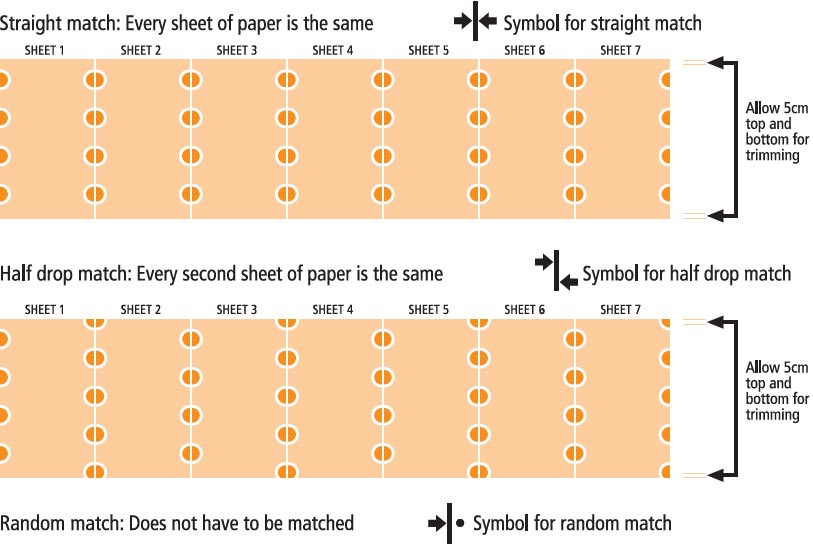
A plumbline must be used to hang your first length of paper perfectly straight. Measure the width of the paper you are going to hang. Measure this amount out from the corner (in the direction you are going) less 15mm. Put a mark close to the ceiling at this point. This is where you hang your plumbline from and will allow a 15mm overlap around the corner. Mark down the plumb line every 300/400 mm. This will give you a good vertical line to hang your first length to.
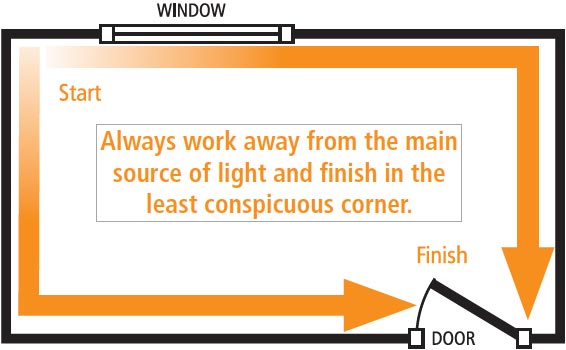
Follow the pasting/soaking instructions on the wallpaper as these do differ from wallpaper to wallpaper. Some are supplied pasted, some unpasted. Prepasted and unpasted wallpapers need to be soaked so they can relax and expand before being hung. This process cannot be rushed, so take your time.

Hang the first strip in line with your plumbline
Loosely roll your cut lengths from the bottom with the pattern on the inside. Fill the water trough approximately two thirds full with lukewarm water. Immerse the rerolled length into the water trough, making sure the entire length is fully immersed for the required time (approx 15 seconds). Feed the leading edge of the paper under the wire in the trough and pull up slowly. Wet a strip across the back of the paper to test for the presence of paste before wetting. If only a small amount of paste is detected treat the wallpaper as unpasted. Ensure that all the paste on the back of the paper is fully wetted. Place the wetted paper on the wall and leave for three minutes to fully relax and expand before final placement. Trim and repeat this process following the instructions on the wallpaper label.
Most unpasted wallpapers are imported and require pasting and a longer soaking and relax time before hanging. Mix the recommended paste to the correct consistency indicated on the paste’s packaging and leave for the required time (approximately 15 minutes) before using. Place the cut paper on a table or flat work surface, pattern side down. Paste the back of the paper with a good amount of paste, making sure that the paste has been applied right to the edges. Fold the paper, paste to paste, with a small fold at the bottom and a large fold at the top. Leave the paper to relax before hanging, between 7-10 minutes. Some products may require up to 20 minutes to fully relax before they are ready for hanging.
To hang, unfold the top section of the length and place it onto the wall in line with the plumb line. Smooth out with a brush starting from the centre of the length out to the edges, then unfold the bottom section and smooth out in the same way. Trim and repeat this process for the next strip.
Carefully read and follow the manufacturer’s instructions on the wallpaper label.
Always strike a new vertical line on each wall. Use a wallpaper smoothing brush or smoother to apply the wallpaper to the wall. Move from the centre of your length to the edges, pushing any bubbles away as you go. If the paper creases or wrinkles, carefully pull the paper from the bottom past the crease and slowly smooth back into place and trim. Don’t rush.
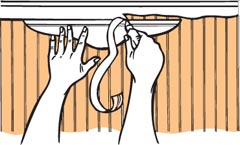
Use a straight edge and a sharp knife when trimming excess.
Once the wallpaper is in place, trim the excess wallpaper at the top and bottom of the wall. Use a sharp snap off blade knife and straight edge to make the cuts. Push the paper into the ceiling line and skirting. A putty knife is useful to scribe the paper into position. Place your straight edge up against the ceiling and trim along the edge of the straight edge then repeat at the skirting. Remember to remove all excess paste from ceiling and skirting. Butt the edge of subsequent lengths of wallpaper to the already hung lengths taking care to ensure you match the pattern.
Inside corners should be hung in two pieces. Measure top and bottom from the edge of the last length hung into the corner. Take the largest distance and add 15mm. Transfer this measurement to the length of paper to be hung, cut at this measurement and hang. This will allow 15mm to return onto the next wall.
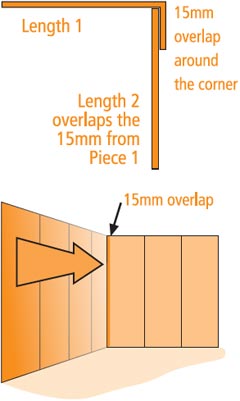
Measure the piece of wallpaper that is left and make a new vertical line at this measurement from the corner in the direction you are going. Hang the second length of paper to this plumb line, working from the plumb line back into the corner overlapping the 15mm from the first length.
In corners where vinyl laps vinyl, use a special vinyl to vinyl adhesive such as Metylan Border Adhesive. Wallpaper will remain workable for approximately 10-15 minutes after soaking or pasting, so take your time to get the strip into the right position and well smoothed before moving onto the next strip. Always strike a new vertical line on each wall.
To hang around doors and windows it is best to hang the full strip of wallpaper so it overlaps the frame and smooth it into place to the edge of the door or window frame. Diagonally cut the wallpaper to the corners of the door or window frame so that the wallpaper is lying smoothly against the wall. Trim the excess off around the frame using a straight edged knife.
Switches and powerpoints may be neatly wallpapered by hanging the strip of wallpaper so it covers the unit. Mark the four corners of the switch using a pencil and connect these together to establish the outline. Lift the paper and using scissors cut from the centre of the area outwards. Working one side at a time, push the flap over the edge of the unit, smooth down and trim off excess.
Switch off power at mains before working around electrical fittings.
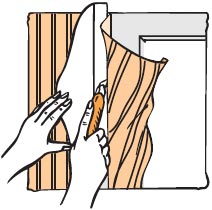
To hang around doors, overlap the full strip,cut, smooth it into place and trim
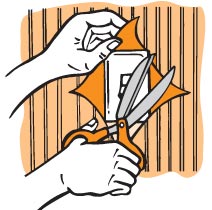
Cover switches and powerpoints and cut from the center outwards
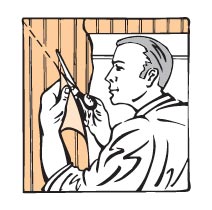
Make diagonal cuts into the corners when papering around fittings and trim
A large selection of non-woven wallpaper is now available, which is suitable for the paste the wall method of hanging. Only use this method for non-woven papers. Consult your Resene ColorShop before you start if in doubt.
Preparation of the wall remains the same as when hanging any wallpaper the traditional way. Preparation is the most important part of decorating interior walls.
Resene recommend Halls Beeline paste diluted to the instructions on the packet for Paste the Wall product.
The coverage is approximately 3 litres of mixed paste per 25 metre roll. (This equates to 12.5m2 or 5 x 2.4 metre drops of wallpaper).
Apply the paste to the wall using a 8mm Dacron roller or brush. Use a brush to get the paste into corners and edges.
Paste the equivalent area of the wall for the number of drops that can be hung within 10-20 minutes, or simply paste for one drop at a time depending on the wall absorbing the moisture or drying conditions in general. If the paste dries too quickly, simply re-paste the wall before hanging the next drop.
Apply directly from the roll onto the wall and trim, leaving approximately an extra 5cm on top and bottom. The same allowance applies when hanging a pre-cut strip or drop.
Once positioned correctly, smooth out from the centre to the edges using a smoother. Smooth out all bubbles and ensure the edges are firmly in contact with the wall. Do not use a seam roller.
Continue the wallcoverings onto the ceiling and skirting then trim any excess at top and bottom with a straight edge and snap-off knife. Use a sharp blade at all times to avoid ripping of wallcoverings.
Inside corners are rarely true and should be hung in two strips. When vinyl overlaps vinyl Shurstik Stick Down adhesive must be used.
Always wash down the seams, skirtings and architraves with clean water as you go. No paste residue should be left on the surface of wallcoverings, as this may show up once the wallcovering is dry.
Reverse hanging: where the wallpaper is textural and non directional or plain, for the best result drops should be reverse hung as indicated on the label. Reverse every second drop.
Borders are an optional extra when it comes to wallpapering but are often used as a way of adding colour or pattern into a room. Most borders are sold in 5m or 10m lengths.
If planning a horizontal border, decide the height you would like the border to appear at and then use a level to determine a true horizontal line. Use the level as your guideline to hang the border.
When hanging pasted or unpasted borders over vinyl wallpaper, a vinyl to vinyl adhesive such as Shurstik Border Adhesive must be used. Make sure that all excess adhesive is washed off before it dries.
Whenever the surface you are about to wallpaper is discoloured, sunburnt or has water soluble stains, apply a full coat of Resene Sureseal pigmented sealer to the entire surface. Once dry, sand the surface with 80 grit sandpaper to give a good key/grip for your size and paste to stick to. Dust the entire surface to remove all dust particles.
When stripping wallpaper use a wallpaper stripper such as Metylan Wallpaper Remover. Don’t use liquid detergent.
Never assume that windows and doors are straight or true or that the height is precise all the way around the room. Always measure and use your plumb line to ensure your wallpaper is hung true and straight.
Always allow your wallpaper to dry naturally after hanging. Do not try to hurry the drying process by using a heater. Force drying the wallpaper will cause the joins to open during the drying process. In cold, damp, unventilated conditions, drying may take up to 1 week.
Change the water in the trough after every 3 lengths or 10 minutes.
Do not use a seam roller and don’t apply too much pressure to the seams or you will squeeze out the paste and the edges will lift.
Wipe off excess paste and water after each length. A towel under the water trough is a good idea.
It is not necessary or recommended to repaste ready pasted wallpaper.
Anaglypta and Paint On wallpaper manufacturer’s instructions must be carefully followed.
Read the instructions on the rear of the wallpaper label before starting.
Before you begin, check your wallpaper roll by roll to ensure that you have the correct pattern, colour and sufficient quantity of the same lot number.
If after hanging three lengths defective wallpaper is discovered, stop and contact us.
 |
No match |  |
Straight match |  |
Half drop match |  |
Distance between repeat / Distance offset |
 |
Direction of hanging |  |
Reverse alternate lengths |
 |
Spongeable |  |
Washable |
 |
Super-washable |  |
Scrubbable |
 |
Sufficient light fastness |  |
Good light fastness |
 |
Strippable |  |
Peelable |
 |
Pre-pasted |  |
Paste the wall |
 |
Paste the paper |
Wallpaper technology has improved so much that wallpapering is so much easier than you might remember or think it it.
Resene Paint and Decorating Problem Solver
Learn more about typical painting problems and situations you may find when decorating.